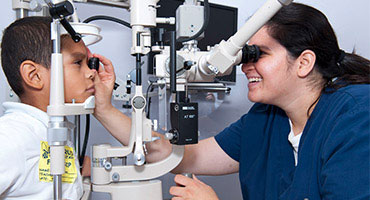 Providing support to children impacted by Hurricane Harvey
Providing support to children impacted by Hurricane Harvey
The See to Succeed Program (STS) is a safety-net vision program for Houston’s underserved children. The program provides comprehensive free eye exams and eyeglasses to those who have failed a school screening, but cannot access optometry services. Each year this high impact program eliminates barriers to learning and academic achievement by helping children to realize their full potential, with documented improvements in their academic and behavioural performance.
Optometry Giving Sight was delighted to step up as a new partner for the See to Succeed program by co-funding the first event of the 2017-2018 academic year. Our support came at a particularly vulnerable time for the children of Houston. Families were struggling to recover from Hurricane Harvey and the ensuing floods, which left thousands of children displaced from their homes.
1,879 students were examined between October 23-27 with 94% requiring glasses and 226 referred for medical follow-up. The clinic was staffed over the five days by 44 optometrists and 25 optical students.

The real impact, however, is demonstrated by the following case studies.
Case 1: A 10-year-old African American female presented to the clinic with an abnormally high myopic prescription (Right eye: -12.50 -1.25 x124 and Left eye; Left Eye -14.25 -1.50 x 080). With such a high prescription, extra consideration must be taken to ensure the patient is not suffering from holes, tears, or detachments inside the eye. While myopic retinal degeneration does not inflict any pain for the patient, this can bring a multitude of other problems including permanent vision loss if not caught early. This project will ensure closer monitoring of the patient.
Case 2: An 8-year-old Hispanic male was diagnosed as being a glaucoma suspect due to significant optic nerve head asymmetry in appearance. He will now be seen for additional testing to further investigate his ocular health. Because glaucoma can eventually lead to irreversible vision loss, the sooner it is caught, the better the visual prognosis is for the patient. Without having had this eye exam, this child may not have been identified as at risk for glaucoma until much later in life, if at all. Because glaucoma can often run in families, it will benefit his family members to also be seen for eye examinations.
Case 3: In the case of a 12-year Pacific Islander male being treated for ADHD, a strong color vision deficiency was uncovered. This was unbeknownst to the child, his parents, or his teachers. The child was originally brought for an eye exam due to difficulty with function in the classroom. Upon finding an otherwise relatively normal eye examination result, we can confidently say that many of this child’s perceived learning difficulties stem from an inability to differentiate colors well. Color vision deficiencies make for difficult environmental interactions. With this knowledge, appropriate accommodations can now be made both at home and at school to help him thrive.

